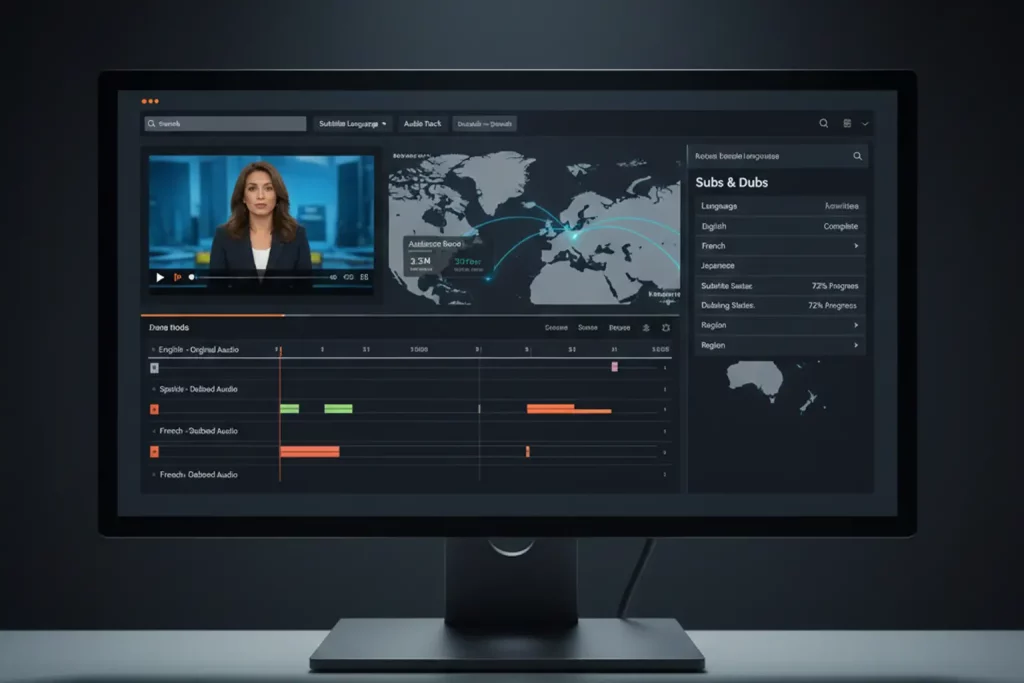In today’s fast-paced digital world, quickly and efficiently discovering media content is more crucial than ever. Media content discoverability isn’t just a nice-to-have functionality; it’s necessary for organizations aiming to stay competitive. As the amount of media content grows exponentially, so does the complexity of managing and finding valuable assets. Advanced solutions leveraging AI are revolutionizing how media assets are managed and discovered.
AI-driven tools have emerged as powerful assets in the media industry, offering solutions that streamline media asset management, enhance metadata generation, and improve overall media workflows. This article delves into the intricacies of media content discoverability, analyzes the role of AI in media asset management, and explores the critical factors that impact the efficient retrieval of media assets.
The Importance of Media Content Discoverability
Media content discoverability refers to the ease with which media professionals can find and retrieve content from vast libraries of digital assets. Efficient discoverability is essential for several reasons:
- Efficient Content Retrieval: The faster media professionals locate the required content, the more efficient their workflows become, translating to cost savings and better resource utilization.
- Improved Viewer Engagement: Easily discoverable content can be more readily repurposed and delivered to audiences, enhancing viewer engagement and satisfaction.
- Enhanced Production Workflows: Streamlining the process of finding and managing media assets leads to more agile production workflows, reducing time to market for new content.
Challenges Faced by Media Professionals in Achieving High Discoverability
Despite its importance, achieving high media content discoverability is fraught with challenges:
- Volume of Content: As media content grows, managing and indexing this content becomes increasingly complex.
- Inconsistent Metadata: Inaccurate or inconsistent metadata can make content difficult to find, even if it exists within the digital library.
- Resource Constraints: Media organizations often lack the resources to manually tag and manage assets comprehensively.
Introduction to AI in Media Asset Management
AI-driven solutions are designed to address the challenges associated with media asset management and discoverability. They offer a suite of features that automate and enhance metadata generation, making it easier for media professionals to find and manage their assets.
Key Features of AI-Driven Solutions:
- Automated Metadata Generation: Utilizes AI algorithms to generate accurate and comprehensive metadata for media assets automatically.
- Seamless Integration with PAM and MAM Systems: Integrates effortlessly with Production Asset Management (PAM) and Media Asset Management (MAM) systems to streamline workflows.
- Real-Time Indexing and Analysis: Provides real-time indexing and metadata updates, ensuring that content is always easily discoverable.
Benefits of Using AI in Media Asset Management
AI-driven tools offer several benefits that significantly improve media asset management:
- Increased Efficiency: Automated metadata generation reduces the need for manual tagging, saving time and resources.
- Enhanced Accuracy: AI-driven tools ensure that metadata is accurate and consistent, improving the overall quality of media asset management.
- Scalability: Easily scales to handle growing volumes of content, making it suitable for organizations of all sizes.
Enhancing Media Content Discoverability with AI
AI enhances media content discoverability through several key mechanisms:
- Automated Metadata Tagging for Quick Content Identification: AI makes it easier to tag and categorize media content by automatically generating detailed metadata, leading to quicker identification and retrieval.
- Enhanced Searchability Through Accurate and Comprehensive Metadata: Comprehensive metadata allows for more precise search queries, ensuring that users can find exactly what they’re looking for without sifting through irrelevant results.
- Real-Time Indexing for Timely Content Retrieval: AI-driven tools’ real-time indexing capabilities ensure that new content is immediately available for search and retrieval.
Case Studies of Media Organizations That Have Benefited from AI
Several media organizations have reaped substantial benefits from implementing AI-driven tools. For instance:
- Major Broadcasting Networks: By integrating AI solutions, a major broadcasting network improved its content retrieval time by 40%, resulting in faster production cycles and enhanced workflow efficiency.
- Independent Media Producers: Small independent media producers found that AI allowed them to manage their content libraries more efficiently, freeing up resources to focus on content creation.
The Role of AI in Media Asset Management
Artificial Intelligence (AI) has become a game-changer in media asset management. By automating the metadata generation process, AI reduces the time and effort involved in manual tagging. AI algorithms can analyze video and audio content, recognizing elements like faces, objects, speech, and sentiment to produce comprehensive metadata.
How AI-Driven Tools Like MetadataIQ Can Transform Media Asset Management
AI-driven tools such as MetadataIQ are transforming media asset management in several ways:
- Efficiency: By automating repetitive and time-consuming tasks, AI-driven tools allow media professionals to focus on more strategic activities.
- Accuracy: AI can analyze vast amounts of data with a level of consistency and accuracy that is difficult for humans to achieve, leading to more reliable metadata.
- Scalability: AI tools can handle growing volumes of media content without a corresponding increase in human resources, making them highly scalable.
Future Trends in AI and Media Content Discoverability
The future of AI in media content discoverability looks promising, with several trends on the horizon:
- Advanced Natural Language Processing (NLP): Improvements in NLP will enable even more accurate analysis of spoken and written content, enhancing metadata quality.
- Predictive Analytics: AI will increasingly predict content trends and viewer preferences, allowing for more strategic content management.
- Deep Learning: Advances in deep learning algorithms will improve content recognition accuracy, from identifying specific objects to understanding complex scenes.
Key Features of MetadataIQ for Improved Discoverability
MetadataIQ offers several features that are specifically designed to enhance media content discoverability:
- AI-Driven Metadata Generation: Utilizes advanced AI algorithms to generate detailed and accurate metadata automatically.
- Customizable Indexing Options: This option allows users to customize indexing criteria to suit their needs, ensuring that the most relevant metadata is prioritized.
- Integration Capabilities with Existing Systems: Seamlessly integrates with existing PAM and MAM systems, ensuring that workflows remain uninterrupted.
Implementation and Best Practices
Steps to Implement AI Tools in a Media Organization
Implementing AI tools in a media organization involves several key steps:
- Assessment: Conduct a thorough assessment of your current media asset management processes to identify areas that need improvement.
- Integration: Work with the AI tool’s integration team to integrate the tool seamlessly with your existing PAM and MAM systems.
- Training: Provide training for your team to ensure they are familiar with the AI tool’s features and capabilities.
- Optimization: Regularly review and optimize your use of the AI tool to maximize its benefits.
Best Practices for Optimizing Media Content Discoverability Using AI
To optimize media content discoverability using AI, consider the following best practices:
- Consistent Metadata Standards: Ensure that metadata standards are consistently applied across all content to maintain accuracy.
- Regular Updates: Regularly update AI tools for new features and improvements.
- User Feedback: Encourage user feedback to identify any issues or areas for improvement.
Tips for Ensuring Accuracy and Consistency in Metadata
To ensure that your metadata remains accurate and consistent:
- Quality Control: Implement quality control measures to review and verify metadata regularly.
- Training: Provide ongoing training for your team to ensure they understand the importance of accurate metadata.
- AI Enhancement: Utilize AI tools to automate and enhance metadata generation, reducing the risk of human error.
Conclusion
In summary, AI-driven tools offer a powerful solution for enhancing media content discoverability. By leveraging AI-driven metadata generation and real-time indexing, these tools transform media asset management, making it easier for media professionals to find and manage their assets. The benefits of increased efficiency, enhanced accuracy, and scalability make AI-driven tools invaluable for any media organization.
Adopting AI-driven solutions is a strategic move for media professionals looking to improve their content discoverability. Consider exploring the latest tools and technologies available to see how AI can revolutionize your media asset management.
This article focuses on media content discoverability, media asset management, metadata generation, AI in media, and the capabilities of AI-driven tools. It aims to provide a comprehensive and informative guide for media professionals seeking to enhance their workflows and content management processes.
Digital Nirvana: Empowering Knowledge Through Technology
Digital Nirvana stands at the forefront of the digital age, offering cutting-edge knowledge management solutions and business process automation.
Key Highlights of Digital Nirvana –
- Knowledge Management Solutions: Tailored to enhance organizational efficiency and insight discovery.
- Business Process Automation: Streamline operations with our sophisticated automation tools.
- AI-Based Workflows: Leverage the power of AI to optimize content creation and data analysis.
- Machine Learning & NLP: Our algorithms improve workflows and processes through continuous learning.
- Global Reliability: Trusted worldwide for improving scale, ensuring compliance, and reducing costs.
Book a free demo to see how you can create metadata and indexing strategy for your media assets with minimal effort and get a firsthand experience of Digital Nirvana’s services.
FAQs:
1. What is media content discoverability, and why is it important?
Media content discoverability refers to the ease with which media professionals can find and retrieve digital assets from vast libraries. It’s crucial because efficient discoverability improves workflow efficiency, reduces costs, enhances production processes, and ensures proper royalty management for media organizations.
2. What challenges do media professionals face in achieving high content discoverability?
Media professionals face challenges such as managing the growing content volume, dealing with inconsistent metadata, and often lacking the resources to manually tag and manage assets comprehensively.
3. How can AI-driven tools enhance media content discoverability?
AI-driven tools enhance discoverability by automating metadata generation, providing real-time indexing, and ensuring accurate and comprehensive metadata. This leads to quicker content identification, precise searchability, and timely retrieval.
4. What are the benefits of using AI in media asset management?
The benefits include increased efficiency through automated processes, enhanced accuracy with consistent metadata, scalability to handle growing content volumes, and streamlined workflows that allow media professionals to focus on strategic activities.
5. What steps should a media organization take to implement AI tools for asset management?
Key steps include conducting a thorough assessment of current processes, working with AI tool integration teams for seamless integration, providing training to the team on the tool’s features, and regularly reviewing and optimizing the use of the AI tool to maximize benefits.




